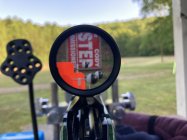The nice thing about my Hood flags is that they have enough vane and the extension of the front weight or daisy is adjustable, so experimenting for best result on the range is easy. I use the light lead weight that is designed to be used to secure and help balance with the daisy, without the daisy, extended as far forward as the shaft will go. That gives me the best response while quickly coming to a stable reading. One option on the Graham flags is a thumb screw at the top of the pivot block that allows front to rear adjustmet of the shaft position and its attachments. I do not remember if your flag has this feature, but I suppose that if you have determined what works best, it may not be needed. In any case, I have always favored doing on the range experiments for a lot of things, but I have observed that this like of experimenting is by no means universal. At the Visalia matches, over time, flags have become simpler, with fewer and fewer daisy wheels. For a time there was an upsurge of the Beggs indicators but that sort of went away, although there are some of that type from time to time.
Unrelated to the discussion of flag design, more about the nature of what we are trying to see.....one time I put one of the Beggs units near one of my flags at about 35 yards. the While I was sitting there watching, the shaft on the Beggs snapped over as far to the left as it could go, and immediately returned to its previous near center position. The regular flag had not shown a thing.
Unrelated to the discussion of flag design, more about the nature of what we are trying to see.....one time I put one of the Beggs units near one of my flags at about 35 yards. the While I was sitting there watching, the shaft on the Beggs snapped over as far to the left as it could go, and immediately returned to its previous near center position. The regular flag had not shown a thing.













